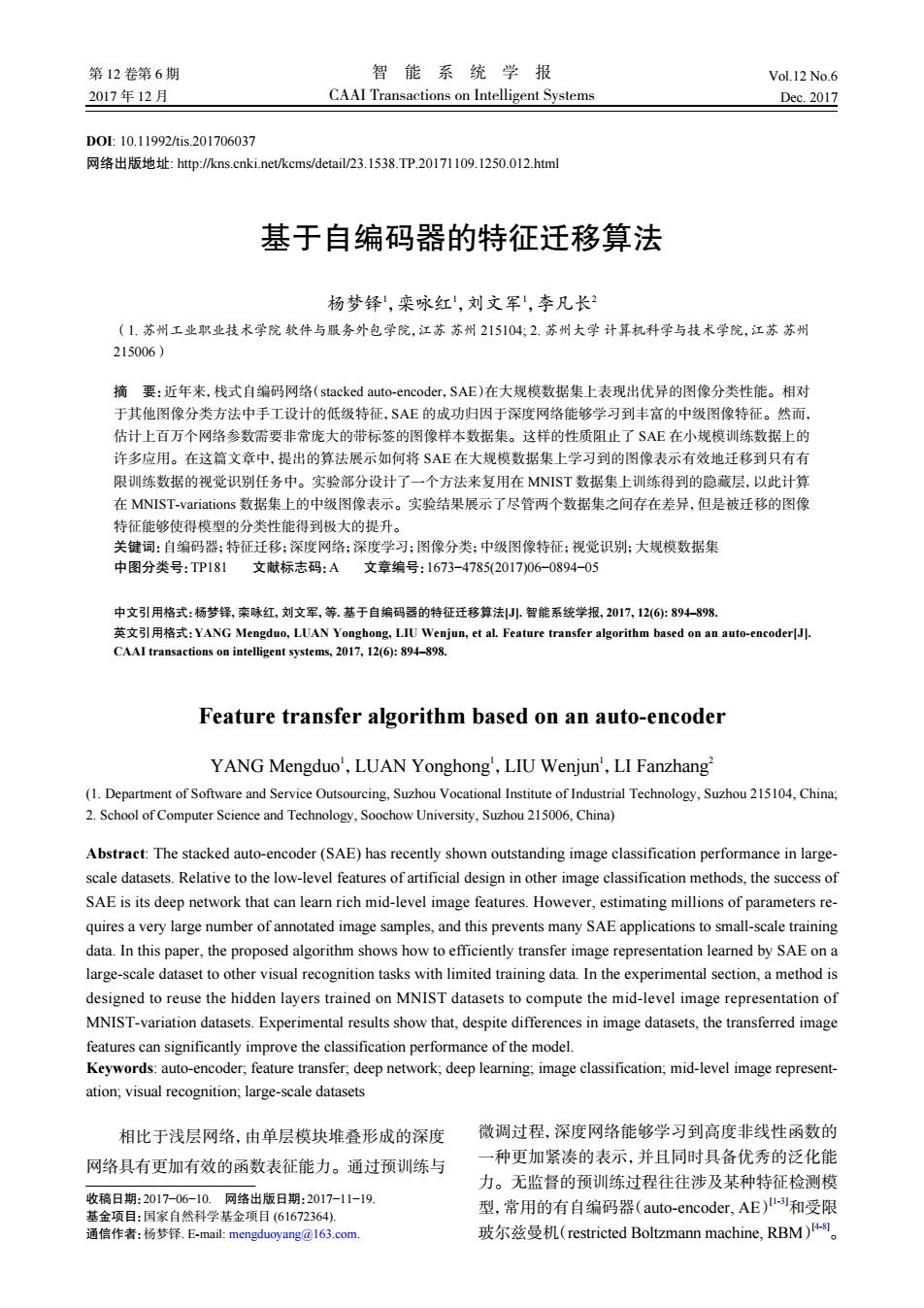正在加载图片...

第12卷第6期 智能系统学报 Vol.12 No.6 2017年12月 CAAI Transactions on Intelligent Systems Dec.2017 D0:10.11992/tis.201706037 网络出版地址:http:/kns.cnki.net/kcms/detail/23.1538.TP.20171109.1250.012.html 基于自编码器的特征迁移算法 杨梦铎,栾咏红,刘文军,李凡长2 (1.苏州工业职业技术学院软件与服务外包学院,江苏苏州215104:2.苏州大学计算机科学与技术学院,江苏苏州 215006) 摘要:近年来,栈式自编码网络(stacked auto-encoder,SAE)在大规模数据集上表现出优异的图像分类性能。相对 于其他图像分类方法中手工设计的低级特征,SAE的成功归因于深度网络能够学习到丰富的中级图像特征。然而. 估计上百万个网络参数需要非常庞大的带标签的图像样本数据集。这样的性质阻止了SAE在小规模训练数据上的 许多应用。在这篇文章中,提出的算法展示如何将SAE在大规模数据集上学习到的图像表示有效地迁移到只有有 限训练数据的视觉识别任务中。实验部分设计了一个方法来复用在MNST数据集上训练得到的隐藏层,以此计算 在MNIST-variations数据集上的中级图像表示。实验结果展示了尽管两个数据集之间存在差异,但是被迁移的图像 特征能够使得模型的分类性能得到极大的提升。 关键词:自编码器;特征迁移:深度网络:深度学习:图像分类;中级图像特征;视觉识别;大规模数据集 中图分类号:TP181文献标志码:A文章编号:1673-4785(201706-0894-05 中文引用格式:杨梦铎,栾咏红,刘文军,等.基于自编码器的特征迁移算法J小.智能系统学报,2017,12(6):894-898. 英文引用格式:YANG Mengduo,.LUAN Yonghong,LIU Wenjun,etal.Feature transfer algorithm based on an auto-encoder[J. CAAI transactions on intelligent systems,2017,12(6):894-898. Feature transfer algorithm based on an auto-encoder YANG Mengduo',LUAN Yonghong',LIU Wenjun',LI Fanzhang (1.Department of Software and Service Outsourcing,Suzhou Vocational Institute of Industrial Technology,Suzhou 215104,China; 2.School of Computer Science and Technology,Soochow University,Suzhou 215006,China) Abstract:The stacked auto-encoder(SAE)has recently shown outstanding image classification performance in large- scale datasets.Relative to the low-level features of artificial design in other image classification methods,the success of SAE is its deep network that can learn rich mid-level image features.However,estimating millions of parameters re- quires a very large number of annotated image samples,and this prevents many SAE applications to small-scale training data.In this paper,the proposed algorithm shows how to efficiently transfer image representation learned by SAE on a large-scale dataset to other visual recognition tasks with limited training data.In the experimental section,a method is designed to reuse the hidden layers trained on MNIST datasets to compute the mid-level image representation of MNIST-variation datasets.Experimental results show that,despite differences in image datasets,the transferred image features can significantly improve the classification performance of the model. Keywords:auto-encoder;feature transfer;deep network;deep learning;image classification;mid-level image represent- ation;visual recognition;large-scale datasets 相比于浅层网络,由单层模块堆叠形成的深度 微调过程,深度网络能够学习到高度非线性函数的 网络具有更加有效的函数表征能力。通过预训练与 一种更加紧凑的表示,并且同时具备优秀的泛化能 力。无监督的预训练过程往往涉及某种特征检测模 收稿日期:2017-06-10.网络出版日期:2017-11-19. 基金项目:国家自然科学基金项目(61672364). 型,常用的有自编码器(auto-encoder,.AE)1和受限 通信作者:杨梦锋.E-mail:mengduoyang@163.com 玻尔兹曼机(restricted Boltzmann machine,.RBM)s。DOI: 10.11992/tis.201706037 网络出版地址: http://kns.cnki.net/kcms/detail/23.1538.TP.20171109.1250.012.html 基于自编码器的特征迁移算法 杨梦铎1 ,栾咏红1 ,刘文军1 ,李凡长2 (1. 苏州工业职业技术学院 软件与服务外包学院,江苏 苏州 215104; 2. 苏州大学 计算机科学与技术学院,江苏 苏州 215006) 摘 要:近年来,栈式自编码网络(stacked auto-encoder,SAE)在大规模数据集上表现出优异的图像分类性能。相对 于其他图像分类方法中手工设计的低级特征,SAE 的成功归因于深度网络能够学习到丰富的中级图像特征。然而, 估计上百万个网络参数需要非常庞大的带标签的图像样本数据集。这样的性质阻止了 SAE 在小规模训练数据上的 许多应用。在这篇文章中,提出的算法展示如何将 SAE 在大规模数据集上学习到的图像表示有效地迁移到只有有 限训练数据的视觉识别任务中。实验部分设计了一个方法来复用在 MNIST 数据集上训练得到的隐藏层,以此计算 在 MNIST-variations 数据集上的中级图像表示。实验结果展示了尽管两个数据集之间存在差异,但是被迁移的图像 特征能够使得模型的分类性能得到极大的提升。 关键词:自编码器;特征迁移;深度网络;深度学习;图像分类;中级图像特征;视觉识别;大规模数据集 中图分类号:TP181 文献标志码:A 文章编号:1673−4785(2017)06−0894−05 中文引用格式:杨梦铎, 栾咏红, 刘文军, 等. 基于自编码器的特征迁移算法[J]. 智能系统学报, 2017, 12(6): 894–898. 英文引用格式:YANG Mengduo, LUAN Yonghong, LIU Wenjun, et al. Feature transfer algorithm based on an auto-encoder[J]. CAAI transactions on intelligent systems, 2017, 12(6): 894–898. Feature transfer algorithm based on an auto-encoder YANG Mengduo1 ,LUAN Yonghong1 ,LIU Wenjun1 ,LI Fanzhang2 (1. Department of Software and Service Outsourcing, Suzhou Vocational Institute of Industrial Technology, Suzhou 215104, China; 2. School of Computer Science and Technology, Soochow University, Suzhou 215006, China) Abstract: The stacked auto-encoder (SAE) has recently shown outstanding image classification performance in largescale datasets. Relative to the low-level features of artificial design in other image classification methods, the success of SAE is its deep network that can learn rich mid-level image features. However, estimating millions of parameters requires a very large number of annotated image samples, and this prevents many SAE applications to small-scale training data. In this paper, the proposed algorithm shows how to efficiently transfer image representation learned by SAE on a large-scale dataset to other visual recognition tasks with limited training data. In the experimental section, a method is designed to reuse the hidden layers trained on MNIST datasets to compute the mid-level image representation of MNIST-variation datasets. Experimental results show that, despite differences in image datasets, the transferred image features can significantly improve the classification performance of the model. Keywords: auto-encoder; feature transfer; deep network; deep learning; image classification; mid-level image representation; visual recognition; large-scale datasets 相比于浅层网络,由单层模块堆叠形成的深度 网络具有更加有效的函数表征能力。通过预训练与 微调过程,深度网络能够学习到高度非线性函数的 一种更加紧凑的表示,并且同时具备优秀的泛化能 力。无监督的预训练过程往往涉及某种特征检测模 型,常用的有自编码器(auto-encoder, AE) [1-3]和受限 玻尔兹曼机(restricted Boltzmann machine, RBM) [4-8]。 收稿日期:2017−06−10. 网络出版日期:2017−11−19. 基金项目:国家自然科学基金项目 (61672364). 通信作者:杨梦铎. E-mail: mengduoyang@163.com. 第 12 卷第 6 期 智 能 系 统 学 报 Vol.12 No.6 2017 年 12 月 CAAI Transactions on Intelligent Systems Dec. 2017